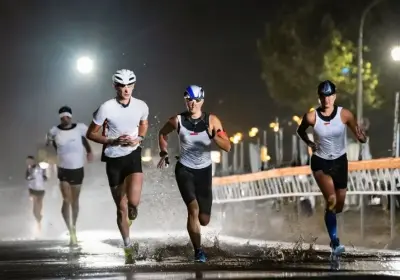Everything to know about Ironman

- 1. The Concept of Ironman: A Comprehensive Introduction
- 2. The Rigorous Training Required for an Ironman Event
- 3. Understanding the Three Disciplines
- - The Art of Long-Distance Swimming
- - The Challenges of Ironman Biking
- - Mastering the Ironman Marathon
- 4. Essential Nutrition and Hydration Strategies for Ironman
- - Calculating Energy Needs and Balancing Macronutrients
- - Staying Hydrated during Training and the Event
- 5. Executing Race-Day Strategies
- 6. The Importance of Recovery Post-Ironman
1. The Concept of Ironman: A Comprehensive Introduction
In seeking to understand the enigma that is the Ironman, we imprint ourselves onto the annals of sporting history. From its nascency in Hawaii back in the late 70s, Ironman, replete with its gnarly mix of swimming, biking, and running, has surged in popularity reaching global echelons. It’s not just a race; it’s a battle of human resolve against distance and time. It gifts a cathartic experience to those willing to push their limits, molding them into an epitome of endurance and resilience. The emergence of Ironman reflects our yearning for challenges, our unabated hunger for proving human capacities.
- Delving into the History of Ironman
Delving into the compelling history of Ironman, it is captivating to learn its origin. A remarkable endurance event, Ironman started off as a passionate challenge between a group of friends in Hawaii in 1978. To clarify who among them was the fittest—a swimmer, cyclist, or runner, they combined these three long-distance races into a single event. This intense bet gave birth to a race that now celebrates its unmatched grit and determination worldwide. But did you know, it was Navy Commander John Collins, one his spontaneous idea to combine the three races, that actually sparked this concept? And thus, the grueling event named "Ironman" was born. Now, competitors across the globe train to push their limits and test their strength in these defined sporting events. It's not just a race; it's a personal mission, a benchmark of physical and mental strength, a journey of transformation for many. Ignited from a friendly feud, these events now symbolize for many a draft of their personal bests and a mental position of strengths. The history of Ironman serves as a testament to the human spirit and the inherent will to achieve the unlikely and unparalleled. So, when you toe the line on race day, remember, the Ironman is more than a title; it's an embodiment of exceeding human potential.
- Exploring the Rise of Ironman's Popularity
As time whittled on, the appeal of Ironman grew like an uncontrolled wildfire, attracting not just the athletes, but tale-spinners, and the curious at heart as well. But why, you might ask? The sheer grit, unyielding determination, and unfathomable resilience required to conquer the seemingly impossible journey of 140.6 miles make the event incredibly captivating. Like moths drawn to a flame, people found themselves enthralled by the triumphant tales of ordinary humans achieving the extraordinary. The rise of Ironman's popularity is also credited to its portrayal as the epitome of human endurance. The notion of pushing human limits, of testing just how far we can go, has always been a motif that resonates deeply with us. Ironman encapsulates this perfectly; it is not just a test of physical prowess but a battle of mental fortitude as well. And let's not forget the sense of achievement that comes with completing such a herculean task. It's a victory not just over the grueling course, but over self-doubt and physical limitations. In a world craving stories of hope and triumph, the rise of Ironman's popularity seems nothing short of inevitable. It stands as a beacon proving that with endurance, grit, and an iron will, anything can be achieved. And isn't that a story worth telling?
2. The Rigorous Training Required for an Ironman Event
Embarking on the journey to compete in an Ironman event isn't for the faint-hearted. This grueling multi-discipline race mandates the highest form of physical fitness, unwavering determination, and meticulous preparation. Developing the optimal training regimen is a cornerstone to overcoming the Ironman's distinctive challenges. It demands building robust endurance for long, exhaustive hours of swimming, biking, and running. Your training schedule has to be multifaceted, encompassing all three disciplines proportionally, simulating race-day conditions to ensure your body adapts well. Essentially, an Ironman aspirant has to push past norms, breaking barriers of traditional physical conditioning to test resilience and agility in the face of extreme adversities. Ready to dive in and push your limits?
- Building Physical Strength and Endurance
As an aspiring Ironman, you cannot solely rely on strong willpower; the event necessitates structured, rigorous training to build paramount physical strength and endurance. Primarily, a well-rounded strength training program should be incorporated into your routine, crafted to challenge the key muscle groups involved in the triathlon. Such a program should focus on building vital 'core strength', improving stability, reinforcing muscular endurance, and increasing your power output. Over time, these targeted exercises will bolster strength and enhance overall athletic performance. Most importantly, this targeted approach will help prevent common injuries. However, strength alone isn't enough. Endurance is a critical component of Ironman preparation. Building endurance involves structured, consistent aerobic training across all three disciplines: swimming, cycling, and running. Tailored high-intensity interval training (HIIT) sessions, varied pace runs, and long slow distance (LSD) workouts are just a few examples of the kind of training you can utilize. Remember, train smarter, not harder. Balance high-intensity workouts with sufficient recovery time. Embrace your rest days to allow your body to adapt and grow stronger. Your endurance will improve, your fatigue will decrease, and your body will be better prepared to tackle the Ironman challenge.
- Creating a Balanced and Effective Training Schedule
Creating a balanced and effective training schedule for an Ironman event requires more than just raw grit or perseverance; it's a calculated process that incorporates all three disciplines -- swimming, biking, and running. Ironman training schedules vary in complexity, dependent on your fitness level and past experience. A commonly employed strategy involves periodization, a structured approach that progressively overloads the trainee without causing burnout. The training period is often broken down into macrocycles (yearly basis), mesocycles (monthly basis), and microcycles (weekly basis), to ensure a balanced mix of intensity, volume, and recovery. Your swim training might start with shorter, technique-focused sessions. Over the course of your training, these increase in length, focusing on improving your endurance. Biking layers on top of this, beginning with easier rides and building up both the pace and distance. Running often has the most significant impact on your joints, so gradually increasing duration and intensity is key to avoid injury. It's also pivotal to schedule rest and recovery days to allow your body to adapt and improve. Rest days are not optional! They are a crucial part of the training program. Understand that these "off" days often lead to better overall performance in the long run. Remember, training for an Ironman is a marathon, not a sprint. It requires steady, calculated effort, discipline, and strategic planning.
3. Understanding the Three Disciplines
Understanding the Three Disciplines: Succeeding in an Ironman event necessitates mastering the art of long-distance swimming, biking, and marathon running. Each discipline presents its unique challenges, asking for your resolve, strength, and perseverance. The tireless solitude of the swim, battling against rough waves and currents, is a baptism by fire. Transitioning to biking, you’ll embark on an exhilarating, yet grueling journey, spanning across varied terrains. The relentless cadence of your pedaling will test your endurance to its limit. Finally, the marathon – a true testament of mental toughness. The euphoria of nearing the finish line is often diluted by the sheer exhaustion. However, it's this cocktail of grit, sweat, and determination that forms the thrilling saga of Ironman's triathlon. Each discipline uniquely exalting, yet together, they create an unmatched endurance fest.
- The Art of Long-Distance Swimming
The fascinating discipline of long-distance swimming embodies a beautiful amalgamation of skill, endurance, and mental fortitude. In the fiery crucible of an Ironman event, it's the first challenge that athletes face, setting the tone for the rest of the competition. Mastery of this art form demands that aspiring Ironman competitors push their limits and work relentlessly to improve their technique, speed, and stamina in the water. Unlike the predictable environment of a swimming pool, open-water swimming often test one's ability to adapt to changing conditions. These can include swift currents, chilly temperatures, and even unfamiliar aquatic life. Preparation is key—athletes need to acquaint themselves with these variables, adjust their strategy, and train systematically. To excel, competitors must learn to manage their breathing and pace themselves—these are not just mere brisk swims but long, strenuous battles against the daunting waves. Because swimming is such a technical sport, fine-tuning one's stroke is essential. A clean, efficient stroke not only reduces drag but also conserves precious energy that an athlete will need further down the line. A well-structured, targeted training regimen can help competitors build the endurance necessary to successfully complete the swim. Remember, it’s not just about getting through the swim—it’s about breaking through physical barriers and tapping into untapped resilience.
- The Challenges of Ironman Biking
Taking on the Ironman biking aspect is a rigorous endeavor that tests not only your physical stamina, but also your mental fortitude. It's way more than just hopping on a bicycle and pedaling away. The grueling 112-mile journey stands as a true testament to will power. You have to conquer inclines, play nice with the whims of weather, and remember to save enough energy for the marathon that follows. One of the core challenges lies in pacing. It's easy to overestimate your capability only to run out of energy too soon. Another demanding aspect is staying in the aerobic zone for about six hours on the bike, which is like running a marathon at about 70% effort. On top of that, you have to consume nutrition on the bike to remain fueled without getting off your rhythm. But perhaps the biggest test, and certainly not the last, is the mental game to stay on track when the going gets tough. Remember, overcoming these hurdles doesn't require a herculean DNA, rather a careful preparation. From learning to control your pace, practicing in adverse weather conditions, maintaining nutritional intake while on the move, to cultivating mental resilience, these are keys to unlocking your potential in Biking stage of Ironman. Step by step, pedal by pedal - that's how you conquer the Ironman biking challenge.
- Mastering the Ironman Marathon
Becoming proficient in the Ironman Marathon requires a potent combination of unyielding discipline, rigorous training, and a mental tenacity that borders on the indomitable. It's not just about endurance - it's a dance between the mind and the body, with each step fostering a growing familiarity with personal limitations and how to skillfully skirt them. Training for an Ironman Marathon compels you to exhibit and maintain a peerless level of physical fitness. You will need to consistently commit beyond all else to strenuous routine of running, building your ability to sustain prolonged periods of physical stress. This requires adopting an evolving training schedule, gradually increasing your running duration and distance until you can confidently tackle the gruelling 26.2 miles. But, achieving this physical prowess is a journey fraught with a barrage of mental hurdles. Can I really do this? is a question you'll find echoing within the quietest corners of your mind. The answer lies not in your legs, but, ironically, in your mental fortitude. In fact, mastering the Ironman Marathon isn't merely about the physical or mental— it's about knotting them together into an unbreakable cord, ready to pull you over that elusive, golden finish line. So, lace up those running shoes. Are you ready to challenge your barriers and rewrite what's possible?
4. Essential Nutrition and Hydration Strategies for Ironman
When you're training for an Ironman, your nutrition and hydration strategy can make or break your performance. Building up your energy reserves and maintaining a balanced diet are crucial. This means not just counting calories, but also focusing on macronutrients - proteins are essential for muscle repair, carbohydrates provide continuous energy and fats assist in absorbing vitamins. Hydration, as well, plays a key role. It's not about chugging litres of water on the day of the event. It's about keeping well-hydrated throughout your training period. Ironman or not, water fuels our body functions, and skipping on it can lead to underperformance, and worse, health issues. So, ready to suit up your diet for Ironman?
- Calculating Energy Needs and Balancing Macronutrients
Preparing for an Ironman is not just about physical training but also about understanding your body's nutritional requirements. You need to calculate energy needs and balance this with the right intake of macronutrients such as carbohydrates, protein, and fats to optimize performance. So, how do you calculate these energy needs? Well, it involves understanding your Basal Metabolic Rate (BMR), the amount of calories your body needs to function at rest, and adjusting this with your activity level. This lets you estimate your Total Daily Energy Expenditure (TDEE), the actual amount of calories you burn in a day. Now, this is where the balancing comes in. For an Ironman, your diet should be composed of approximately 60% carbohydrates, 15% protein, and 25% fats. Carbohydrates are your primary fuel during long-duration exercises, protein aids in muscle repair and recovery, and fats provide a concentrated source of energy. Remember, the unique demands of Ironman racing mean that your fuel requirements could be higher than that of a regular athlete. So don't underestimate your caloric needs and remember, successful fueling involves trial, adjustment, and more trial. Make sure to consult a sports nutrition expert for personalized advice. After all, the road to becoming an Ironman begins with the fork!
- Staying Hydrated during Training and the Event
Hydrating your body plays a crucial element in preparing for an Ironman event. It goes beyond simply quenching your thirst. Staying properly hydrated throughout your training is pivotal for optimal performance. The human body is roughly 60% water, it plays an indispensable role in every aspect of bodily function. That's why neglecting hydration can lead to detrimental effects like muscle cramping, fatigue, and in severe cases, dehydration. During the event, it's essential to continually replenish the fluids you're losing through sweat. But remember, drinking too much water can cause hyponatremia, a condition where sodium levels in your body become dangerously low. To prevent this, an ideal approach is to balance your fluid intake with electrolytes, such as sodium and potassium. Furthermore, practicing your hydration strategy during training is as critical as the physical training itself. It familiarizes your body and helps to pinpoint the precise amount of fluid intake you'll need on the race day. Without the right hydration strategy, you're compromising not just your performance but your health. Remember, it's not just about how hard you push your body, but also about how well you take care of it.
5. Executing Race-Day Strategies
On race-day, your execution can either make or break your entire Ironman experience. A well-crafted strategy starts with intimate knowledge of the course. Understanding the route, terrain, and probable weather conditions can provide valuable insights for efficient pace management. It's about venturing beyond your capabilities without hitting the wall. This proverbial wall alludes to the point of physical and mental exhaustion where it becomes almost impossible to press ahead. Yet, it's this very barrier that Ironman participants strive to overcome. It's not purely a test of endurance; it's about your resolve, determination, and the undying spirit to succeed against all odds. Remember, the Ironman is as much a journey of the mind as it is of the body, so gear up and embrace the challenge!
- Mapping out the Course: What to Expect
Dedicated Ironman aspirants understand the undeniable importance of **mapping out the course**. Not only does it provide a lay of the land, it also makes you familiar with potential challenges along the journey. It's worth remembering; each Ironman event is unique, with its own distinct features and obstacles, and knowing this can make a world of difference. You can't expect to take on Ironman Texas the same way as Ironman Hawaii, can you? How do you prepare? To start, immerse yourself in **meticulous research**. Make use of detailed race maps and course descriptions. Are there hills on the bike course? Is the swim segment in a lake or ocean? Understanding these factors will heavily influence your training and strategy. Next, consider a **visual walkthrough** if possible. Some athletes make use of apps or videos to get a virtual feel of the course. There’s nothing quite like seeing with your own eyes the terrain you’re about to tackle. If you have the luxury of visiting the course in person before race day, seize that chance! Finally, remember that while **knowledge is power**, flexibility is key. Your race day may throw in a curveball, such as unexpected weather conditions. So, prepare for the planned, but also brace yourself for the unplanned. In the world of Ironman, adaptation is crucial to success.
- Pushing through Physical and Mental Boundaries
Ironman athletes know that pushing through physical and mental boundaries is not just a facet of the training, but an integral part of the race day strategy itself. It's a test of fortitude, resilience, and self-awareness that demands every ounce of strength an athlete can summon. From the starting line to the grueling last mile, every step, pedal stroke, and breath can become a battle against the insistent voice in your head whispering, "You can't do this." Compelling your body to work for hours on end, when it's screaming for you to stop and rest, comes down to sheer mental toughness. It's about staying focused on your goal and reminding yourself of the dedication, sacrifice, and hours of training that have led you to this moment. Equally though, observing mental boundaries is crucial. Understanding your limits, and knowing when to push and when to pull back, prevents injuries and burnouts. It's about balancing the desire to push harder with the necessity of self-care. In the realm of Ironman, the adage holds true - the body only achieves what the mind believes. The route to the finish line cannot be traversed without pushing through physical and mental boundaries, making this journey as much about inner strength as it is about physical endurance.
6. The Importance of Recovery Post-Ironman
The importance of recovery post-Ironman cannot be overstated. Your body has just accomplished an exceptional feat, and it's now begging for rest and recuperation. Just as you've planned your training and nourishment, a well-thought-out recovery strategy is equally imperative. Engaging in gentle activities such as light walking or stretching can facilitate post-race healing by boosting circulation and flexibility. Yet, it's just as vital to allow for plenty of rest, granting your body well-deserved time to heal and restore. Nutrition-wise, replenishing lost fluids and electrolytes, coupled with consuming quality proteins and carbohydrates, aids in muscle repair and energy renewal. Remember, your triumphant journey doesn't end at the finish line; it carries on into recovery and indeed, your next event. Ready for the next step?
- Best Practices for Post-Race Recovery
Ironman events are renowned across the globe for their intensity and rigorousness, thus taking the concept of extreme sports to whole new heights. Once you've crossed the finish line, the journey isn't over. It's a pivotal moment, but what comes after is just as crucial – your post-race recovery. A well-rounded recovery strategy minimizes discomfort and aids in faster recuperation. Here are some best practices sure to support your recuperation. Your bodily systems undergo enormous strain during such a demanding race. The first step, therefore, is to rehydrate and replenish nutrient reserves. Consuming fluid-rich foods and drinks, including a blend of protein and carbohydrates, is essential within the first couple hours of completing the race. Rest is paramount but does not necessarily mean complete "stillness". Active recovery, like light walks or gentle swims, can promote blood flow, relieving muscle soreness. Load up on antioxidants and anti-inflammatory foods, items like berries, nuts, fish, and leafy greens, to combat inflammation. These foods will expedite healing and improve your body’s overall resilience. Lastly, give yourself deserved sleep to optimize the recovery process. Remember, your body has just achieved something massive. Give it time and access to the right building blocks to bounce back stronger.
- Getting Back into Training after an Ironman Event
Embarking on the journey of an Ironman event is no small feat- requiring not just physical grit but also the mental fortitude to go above and beyond one's personal boundaries. But the end of the event doesn't mark the end of your Ironman journey; rather, it signals the beginning of another crucial phase: getting back into training post-Ironman. Athletes often grapple with the question, "How and when should I dive back into training?" The answer varies from person to person as it heavily depends on individual recovery rates, but there are key points to consider for everyone. Firstly, embracing an adequate rest period is an absolute must to recover from the colossal exertion of the Ironman event. Remember, your body and mind both warrant a well-deserved break. This time-off aids in counteracting any possible results of overtraining like burnouts or injuries. Secondly, getting back into training doesn't necessarily mean jumping straight back into high-intensity workouts. Rather, a gradual, phased approach with lower-intensity exercises at the start, slowly building up to your usual training routine, can prove to be much more sustainable and effective. Implementing a balanced approach to resume training promotes endurance, rebuilds ironman strength, and reignites your passion for the sport. Remember, in this post-Ironman phase, it's paramount to listen to your body. Tune into its needs, respect the signals it sends, and cater to it with patience and diligence. This method will not only make your comeback to training safer but also set the stage for your next triumphant Ironman event.
Engaging in an Ironman demands physical fortitude, comprehensive training, and strategic nutrition. It's a true testament to human resilience, pushing participants to overcome their limits. The journey doesn't end at the finish line; recovery is equally crucial for overall health and continued participation. Knowing every facet of Ironman from its history, disciplines, race day strategies to recovery techniques not only paves the path to success but also safeguards wellbeing, making the Ironman challenge an invigorating life experience.
How long does it take to train for an Ironman event?
A typical training plan for an Ironman event lasts 20 to 30 weeks.
What distances are involved in an Ironman triathlon?
An Ironman triathlon involves a 2.4-mile swim, a 112-mile bicycle ride, and a marathon 26.2-mile run.
How many calories does an athlete need during Ironman training?
During Ironman training, an athlete needs to consume about 3,000 to 7,000 calories per day depending on their body size and training intensity.
What are some strategies for staying hydrated during an Ironman race?
Drinking fluids every 15 to 20 minutes, consuming sports drinks high in electrolytes, and eating water-rich foods are some strategies for staying hydrated.
How long should an athlete rest after completing an Ironman event?
After an Ironman event, an athlete should ideally rest for 2-3 weeks before resuming light exercise.


















































Leave a comment